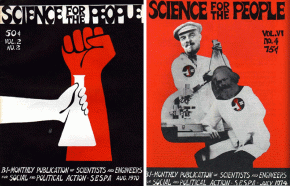When the scientists march
uncovers a history of resistance to the status quo among scientists that is being revived during the Trump era, in an article written for Australia's Red Flag.
BRANDISHING PIECES of coal during parliamentary sessions passes for evidence these days, according to climate change skeptics. In this age of alternative facts, filing lawsuits against the U.S. Environmental Protection Agency (EPA) and the denial of human agency in global warming are key qualifications to head the agency.
During his campaign, Donald Trump promised to reduce the EPA to "tidbits," and since the election, climate change information has been wiped from the agency's website. Orders have been issued that all agency research be vetted.
With the president's edicts and policies posing a threat not just to environmental research, but to the whole world of science, those who work in the discipline are taking to the streets, joined by international protests, on Earth Day, April 22.
This activism by scientists is often greeted with amazement. While acknowledging it's a mark of the widespread nature of Trump's attacks, there's incredulity--after all, who's seen scientists on the streets?

We shouldn't be so surprised. Scientists have quite a history of protest, particularly during times of upheaval.
On the campuses and in the public sector, there have been decades of strikes and protests involving scientists. Most recently in Australia, during the torrid times of Tony Abbott's government and its anti-science agenda, savage cuts to the Commonwealth Scientific and Industrial Research Organization prompted scientists around the country to strike.
In the world of work, science is a relative newcomer, but one intimately tied to the development of capitalism. Karl Marx explained that "modern industry...makes science a productive force distinct from labor and presses it into the service of capital." In the process, it created its own workforce, whose class consciousness has waxed and waned. In the aftermath of the First World War and the Russian Revolution, there was a trebling in the science workforce along with a radicalization.
During the 1930s, British scientists formed a National Union of Scientific Workers, while some, looking for political expression, joined the Labour Party or the Communist Party. With fascism on the rise, scientists were called to decide which side they were on: face either a grim future under fascism or a grand, science-informed "complete Socialism."
Through their publications, membership in left-wing parties, union organizing and antiwar protests, these left-wing scientists had an impact for more than 20 years.
French physicist and communist Paul Langevin, though seeing his scientific work as important, argued, "Unless the political work is done, there will be no science at all."
RADICALISM EBBED during the Cold War, then rose again in the late 1960s with the mass opposition to the Vietnam War, student activism and rising working class combativity. U.S. science workers formed antiwar groups and joined forces with unions and other groups in March 1969 to strike at Massachusetts Institute of Technology and many other workplaces, opposing the military applications of science. Similar protests by scientists against the war also happened in England.
Activists formed the British Society for Social Responsibility in Science. Many in the group had New Left politics and a strong commitment to Third World struggles, and also took a strong stand against British intervention in Northern Ireland. As well, in their Radical Science journal, they took on the pseudoscience supporting racism and sexism in the mainstream media.
Scientist Marianne Craig remembers, "We were going to change the world, we were going to work together...We never went shopping on the weekend. We went to demos."
In the U.S., Science for the People was more openly left wing. "We were basically a load of shit-kicking folks, and we made sure our voices were heard," Al Weinrub recalls. The group argued that science was not neutral, but part of the "ideological and practical weapons used by the existing power structure both here and abroad, to justify racist and sexist oppression."
The group openly backed the Black Panther Party, while the New York branch helped the radical Puerto Rican group Young Lords organize a campaign against lead poisoning. Earlier, they campaigned against IBM and Polaroid, which were integral to apartheid South Africa's passbook system. They exposed the effects of Agent Orange, a project that extended to Australia, where one activist scientist's research informed testimony for Vietnam veterans.
Science activists Steven and Hilary Rose, in The Political Economy of Science, write that, like any other workers who sell their labor to the capitalist class, science workers become alienated from their creations, from the products of their labor.
But as their history has shown, they can also form part of the potential revolutionary forces within society when they organize and fight.
First published at Red Flag.


